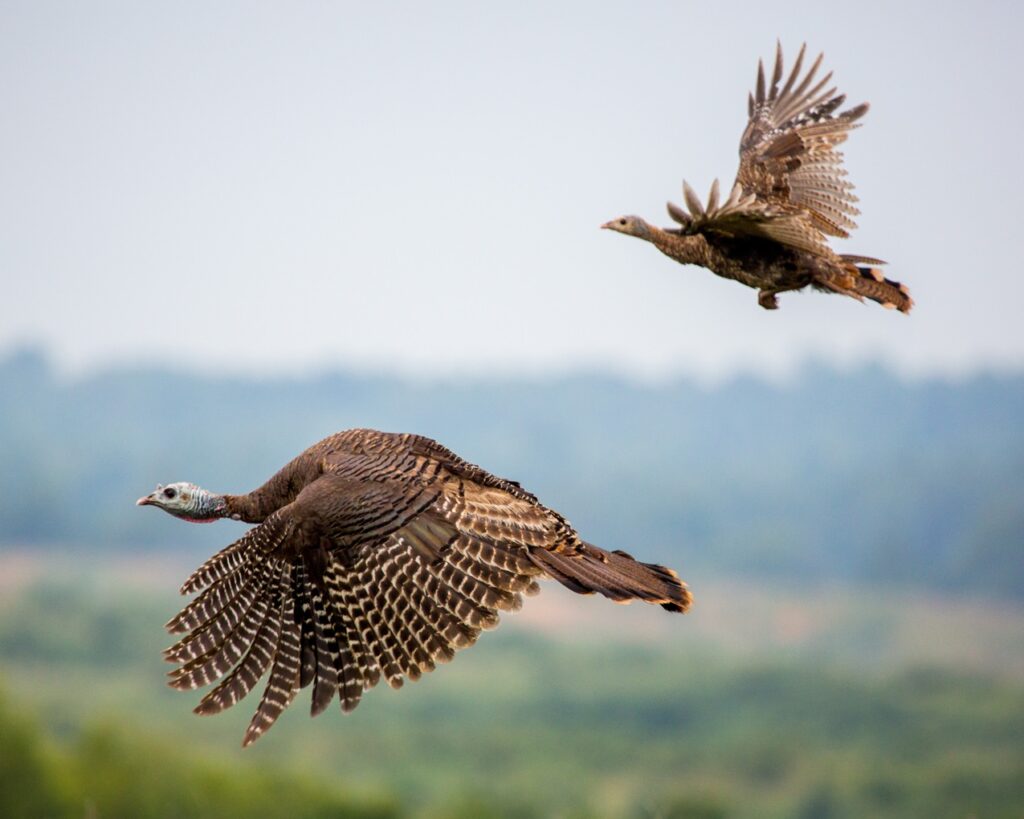The turkey is a ground-dwelling game bird that lives throughout North America. Its enormous body and characteristic gobble make it one of the most recognizable wild birds throughout its range.
When hikers or farmers wander through the woods or fields where turkeys often roam, they may startle the turkeys nearby. When turkeys are scared, they launch into the air loudly, in a flurry of feathers, crashing through branches and leaves.
Wild turkeys can fly, but only for a short distance. They have bodies unsuited to long, sustained flights, but when they fly, they are fast. In addition, turkeys can run fast and swim.
Turkeys are wary and intelligent birds that are challenging to hunt. The people who hunt turkeys invest a lot of time and money pursuing this bird, most of which goes towards funding research and conservation efforts to maintain turkey habitat.
One of the Founding Fathers of the United States, Benjamin Franklin, considered the turkey to be a far more respectable bird than the Bald Eagle, which he believed had a bad moral character. Eventually, however, they chose the bald eagle as the national bird over other birds.

Can Domestic Turkeys Fly?
Many farmers raise turkeys domestically. Turkey is one of the most popular meats consumed in the United States and Europe. The National Turkey Federation estimates that the US eats around 46 million turkeys on Thanksgiving alone.
Domestic turkeys cannot fly. Over many generations, farmers bred domestic turkeys to have larger bodies with larger breasts that provide a lot of meat. These meaty breasts prevent turkeys from having sufficient strength to lift their heavy bodies from the ground.
In addition, domestic turkeys are less intelligent than wild turkeys. Farm-raised birds have lost the instincts that make them a challenge to hunt. Because of this, the term “turkey” is often used as an insult to refer to someone doing something dumb.
How Far and High Can Turkeys Fly?
Turkeys can fly around 300 feet (91 meters) when threatened by potential predators. This distance is enough to escape predation and reach a tree branch that will keep them out of reach of most animals.
Surprisingly, turkeys can quickly explode into action when a potential predator approaches. The resulting crashing sounds indicate a speedy retreat into the trees. Turkeys can fly 50 feet (15 meters) into the air, reaching some of the highest branches where they can roost for the night.
How Fast Can Turkeys Fly?
Turkeys can fly as fast as 50 miles per hour (80 kilometers per hour) when escaping predation. In addition to flying, turkeys can also run. Their long legs allow them to reach running speeds of up to 12 miles per hour (19 kilometers per hour).
If turkeys fall into the water, they can also swim to shore. They are not fast swimmers but will float and kick across the water’s surface until reaching land. Both domestic and wild turkeys may enter a pond or lake on their own and swim around.
When Do Baby Turkeys Fly?
Baby turkeys cannot fly for the first month after hatching. They usually fledge after four weeks and can begin flying into low roosts with their mother. These early flights are generally around 25 to 50 feet (8 to 15 meters).
Once baby turkeys fledge, they can begin roosting with their mothers in the treetops at night. These early flights make them less vulnerable to predation from animals like foxes.
Juvenile turkeys improve their flying skills, and within four to five months, they are ready to be independent of their mother. At that point, they no longer depend on her for protection or food.
Biologists have worked hard throughout North America to increase the turkey population by improving the turkey habitat. Turkeys were once extirpated from some parts of the US, such as Massachusetts, but have since made a comeback.
Do Turkeys Fly South for the Winter?
Turkeys do not migrate south during the winter months. However, they may wander into regions of their range that offer more shelter from the cold winter temperatures and sufficient food during the chilly months. They roost together in trees throughout the day and overnight.
Wild turkeys often gather in large flocks, especially in the extreme northern parts of their range. These large flocks can generate warmth and provide excellent protection during the winter season’s short days and long nights.
Also Read:
Can Swans Fly
Can Chickens Fly
